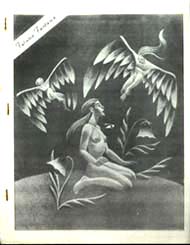Difference between revisions of "Main Page"
(updating featured article) |
|||
| (5 intermediate revisions by the same user not shown) | |||
| Line 21: | Line 21: | ||
|style="color:#000| | |style="color:#000| | ||
| − | [[Image: | + | [[Image:Futuria_Fantasia_copy.jpg|thumb|right|'''Futuria Fantasia''' Issue 4]] |
| + | Futuria Fantasia is a science fiction fanzine by [[Ray Bradbury]]. Released in 1939 shortly after Bradbury graduating high school when he was 18 years old, ''Futuria Fantasia'' was published with the help of Forrest J Ackerman, who lent Bradbury $90.00 for the fanzine. The year before, Ackerman had included in his own zine, [[Imagination!]], the first published story by Bradbury, called "Hollerbochen's Dilemma". | ||
| − | + | Bradbury met Ackerman through the Los Angeles Science Fiction Society, which Ackerman helped to found. It was there that Bradbury also met [[Hannes Bok]] and Emil Petaja. Both were to contribute to the fanzine; Petaja offered his fiction and Bok also contributed stories and poetry, as well as designing the covers and doing the interior illustrations for all four issues, including the cover for a fifth issue that was never printed. | |
| − | + | The first issue, released in Summer 1939, was 6 pages. It included Bradbury's short stories "Don't Get Technatal", under the pseudonym "Ron Reynolds", and the poem "Thought and Space". [[Futuria_Fantasia|Read More...]]''' | |
| − | |||
| − | |||
|- | |- | ||
Revision as of 05:29, 7 June 2012
|
ZineWiki is an open-source encyclopedia devoted to zines and independent media. It covers the history, production, distribution and culture of the small press. |
| Browse by Zine Title: #-D · E-J · K-O · P-S · T-Z |
|---|
| NOTE: Before adding a project to ZineWiki, please browse the Previously Featured Articles for examples of the best ZineWiki has to offer. Keep in mind, ZineWiki is not a classifieds section, it is an encyclopedia. New entries should NOT contain simply a "sample page" and contact information. |
|---|
|
|
